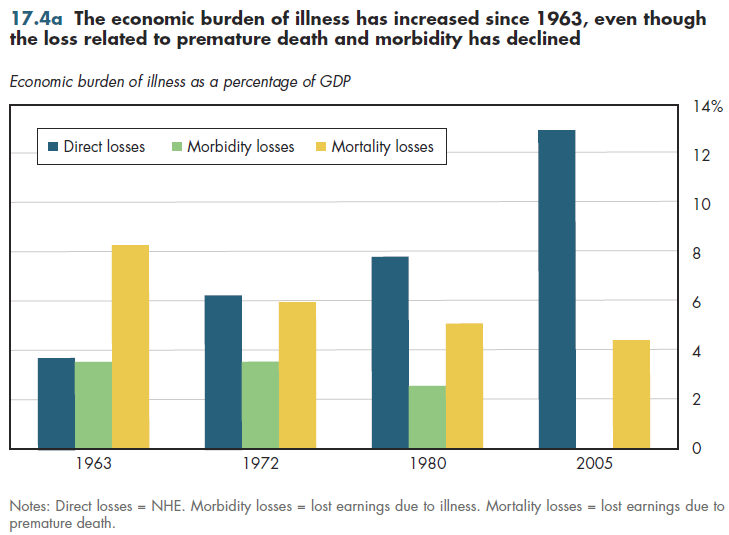Download PowerPoint versions of both figures.
Inside Collection (Book): American Health Economy Illustrated
17.4 Whether Social Burden of Illness Has Increased or Decreased Depends on How It was Measured
Summary: If premature mortality and morbidity are measured in terms of lost production, the social burden of illness has increased since 1963; however, if the intangible value of human life is taken into account, the social burden of illness has declined despite the large increase in health expenditures during this period.
Despite all the medical progress made during the past 50 years, the economic burden of illness appears to be increasing from a cost-of-illness perspective. The aggregate economic burden of illness consists of three components. The first are direct costs, that is, all of NHE, because in one way or another, these expenditures aim to prevent or ameliorate the effects of poor health. Under a broad definition of the health system, non-medical expenditures such as highway barriers could be included if their principal purposes are to save lives. However, the data shown in figures 17.4a and 17.4b are restricted to NHE.

The second component is morbidity losses. In figure 17.4a, these are measured in terms of productivity losses, that is, lost income attributable to workers who are sick. The final component is mortality losses. These also consist of productivity losses except that they are from premature death rather than illness. For simplicity, rather than convert all these dollar amounts to a current-year equivalent, the burdens are expressed as a percentage of GDP. Direct costs—the focus of much of this book—have risen quite rapidly since 1963.
During the same period, mortality losses declined steadily. By 2007, they were just over half of the 1963 level. Morbidity losses did not decline as steeply as mortality losses but did decline between 1963 and 1980. Unfortunately, there are no 2005 data for this measure. However, the rise in direct costs was so rapid between 1980 and 2005 that an unequivocal conclusion is that the aggregate social burden of illness in the United States has increased over the past 50 years. That is, even assuming that morbidity losses had been eradicated by 2005, the sum of direct costs and mortality losses exceeds the total for all three components of the social burden of illness. This increasing economic burden can be attributed solely to increasing health spending in the United States.
However, when the intangible value of human life is taken into account, this conclusion is reversed (figure 17.4b). That is, the value of mortality gains has more than offset the increase in health spending. No good way exists to estimate morbidity losses over time using this approach, but because morbidity was declining as a percent of GDP in terms of lost output, the same would be true were these improvements in health valued in willingness-to-pay terms.

Downloads
References
- Author's calculations.
- Department of Commerce. Bureau of Economic Analysis.
- Department of Commerce. Bureau of the Census.
- Department of Health and Human Services. Centers for Disease Control and Prevention.
- Rice DP, TA Hodgson and A Kopstein. The Economic Costs of Illness: A Replication and Update. Health Care Financing Review 1985; (1):61-80.
- U.S. Health Policy Gateway. Key Questions: How large is the cost-of-illness in the U.S.? http://ushealthpolicygateway.wordpress.com/payer-trade-groups/ burden-of-illness/cost-of-illness-coi/cost-of-illness/ (accessed August 11, 2010).
Collection Navigation
- « Previous module in collection 17.3 Technology Has Been An Important Driver of Health Spending
- Collection home: American Health Economy Illustrated
- Next module in collection » 18.1 US Leads the World in Medical Innovation
Content actions
Give feedback:
Download:
Add:
Reuse / Edit:
Twin Cities Campus:
- © 2012 Regents of the University of Minnesota. All rights reserved.
- The University of Minnesota is an equal opportunity educator and employer. Privacy
- Last modified on Sep 24, 2013 4:19 pm -0500









